#emperors4
Explore tagged Tumblr posts
Photo
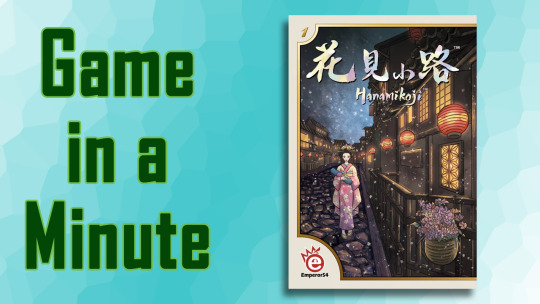
Game in a Minute: Hanamikoji
Hanamikoji is a *gorgeous* 2-player card game where players are traditional restaurant owners, competing to hire the most talented geisha
https://is.gd/uGfRlE
#Deep Water Games#EmperorS4#Kota Nakayama#Maisherly#Mashiro Misaki#2-player games#Board Games#Game In A Minute#Reviews#Video
2 notes
·
View notes
Text
Hanamikoji: Geisha's Road & More Coming to Kickstarter in October
Hanamikoji: Geisha's Road & More Coming to Kickstarter in late October from @boardgame_love
Just saw this on Boardgame Geek over the weekend and since I loved Hanamikoji, I am definitely interested in the new sequel game called Hanamikoji: Geisha’s Road. Designed by Jerry Chiang and Eros Lin with art by Maisherly, the game will be published by Emperor S4 Games. In this game, you’re not trying to attract the most prestigious geishas to your establishment. Instead, you are trying to…
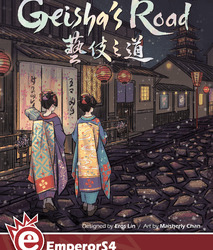
View On WordPress
#2-Player Games#Card Games#EmperorS4#Eros Lin#Hanamikoji#Hanamikoji: Geisha&039;s Road#Jerry Chiang#Lunch Time Games
1 note
·
View note
Photo
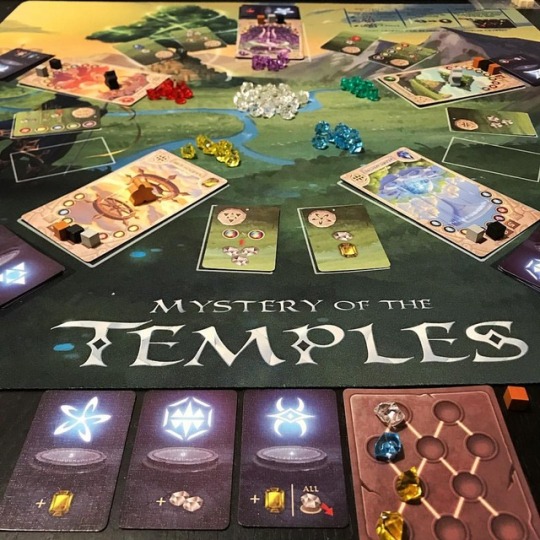
Yep. Mystery of the Temples from @deepwatergames is AWESOME!! Such a simple and clean design that’s oh so addictive. Just played the basic game but I’m itching to try out the advanced rules with player powers! Plus, it’s drop dead GORGEOUS!! 🤤 . . . . . #mysteryofthetemples #deepwatergames #boardgames #emperors4 #boardgamegeek #juegosdemesa #cardgames #jeuxdesociete #tabletop #boardgamer #gamenight #gaymer #geekygaymerguy #ボードゲーム #j2s #brettspiel
#mysteryofthetemples#deepwatergames#boardgames#emperors4#boardgamegeek#juegosdemesa#cardgames#jeuxdesociete#tabletop#boardgamer#gamenight#gaymer#geekygaymerguy#ボードゲーム#j2s#brettspiel
4 notes
·
View notes
Photo
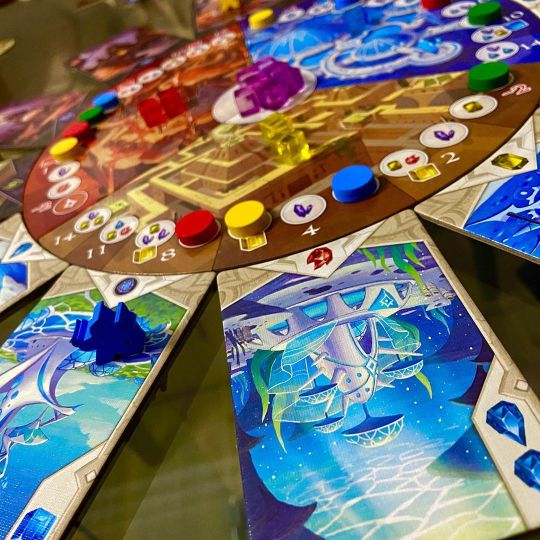
Venha participar dos testes para se consagrar o maior Arquimago em TRIAL OF THE TEMPLES, de Michael Mihealsick e Wei-Min Ling, pela @emperors4games #trialsofthetemple #emperors4 #michaelmihealsick #weiminling #archimage #magic #temples #templos #magia #boardgames #boardgamegeek #bgg #boardgamephotography #spiel19 https://www.instagram.com/p/B5MVZH9B0wz/?igshid=pfjbov5gsxni
#trialsofthetemple#emperors4#michaelmihealsick#weiminling#archimage#magic#temples#templos#magia#boardgames#boardgamegeek#bgg#boardgamephotography#spiel19
0 notes
Text
Wicked Game (Hanamikoji)
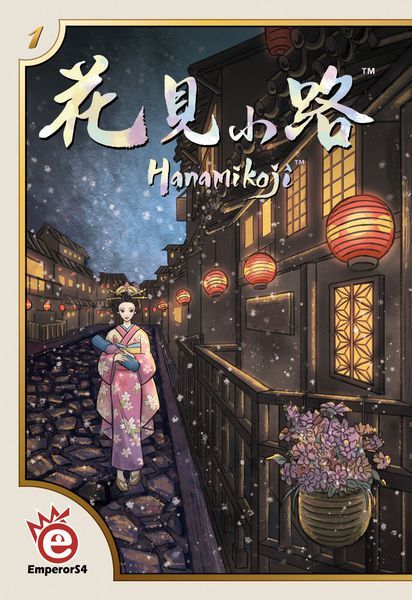
I can think of no game with a simpler ruleset, published with a lovelier, more pleasant, appealing, and understated graphic design, or played with a more head-crushing metagame-rich strategy than Hanamikoji.
Learned in less than five minutes, Hanamikoji presents more difficult decisions in four basic action tiles than many point salad euros can manage in a box full of custom wooden components.
Hanamikoji (2013) Designed by Kota Nakayama Art by Maisherly Published by EmperorS4
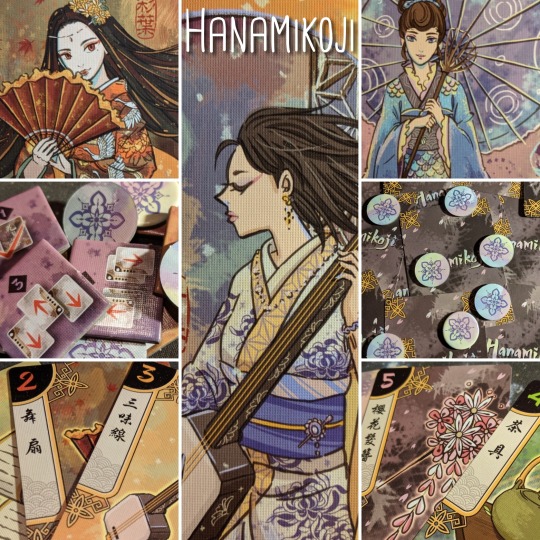
Hanamikoji is the name of a street in Japan’s old capital city, Kyoto, that was known as a hub for geisha (or geiko in Kyoto’s dialect). Wikipedia defines geisha as “women who entertain through performing the ancient traditions of art, dance and singing, and are distinctively characterized by their wearing of kimono and oshiroi makeup.” In all honesty, beyond having a very cursory understanding of geisha, my actual informed knowledge is lacking, to say the least. I can say that with lots of Googling, I’ve learned that geisha are still present in Gion today, the district in Kyoto that has historically been known for them.
Lowdown (How to Play–in a Nutshell)
In Hanamikoji, players compete to win favor of the seven geishas on the street of Hanamikoji. The game is built around four identical action tokens each player has, and relies heavily on the “I split, you choose” mechanic.
At the start of the game, the seven geisha cards are laid out across the center of the table between players. On each geisha is a scoring token used to track which of the two players has “favor” of that particular geisha. Then each player is dealt a hand of six cards. The cards in the game correspond to the geishas on the table (with the #2 geisha having two cards in the deck, the #3 having three cards, and so forth). On your turn, you simply draw a card, then choose one of the four action markers, do the action, and flip over the token to show that it has been completed. The four actions are: 1. Hide a card face-down in front of you (this will remain secret until the end of the round when it will be revealed and scored), 2. Choose two cards from your hand and place them face down in front of you (these will remain hidden and not score at the end of the round, they are functionally discarded), 3. Choose three cards and reveal them to your opponent; they will choose one card to place on their side at the matching geisha, you will take the other two and place them on your side, 4. Choose four cards and reveal them to your opponent; they will choose two cards to place on their side, you will keep the other two.
Once each player has taken all four actions, each player will reveal their hidden card and play it to any geisha on their side. Next, the players will progress down the row of geisha, and for each geisha, move the favor token towards the player that has more cards played on their side at that particular geisha. Each geisha has a point value (ranging from two through five), and the game will end if one player either has either the favor of four geisha, or the favor of geisha whose point values total 11 points or more. In the event one of these conditions is not met, you collect all cards, shuffle, and play again, but do not move the favor tokens back to the center of each geisha card.
Tea for Two (Scaling for Two Players)
This game is playable only as a two-player game, and as such it’s perfect.
She’s So Cold (The Bad Stuff)
It will be difficult to divorce the good from the bad here, because I can imagine someone balking at Hanamikoji's subtleties that I enjoy. With that in mind, let’s talk about what seems to be the most divisive aspect of the game. I’ve read bad reviews for Hanamikoji online, and it seems to be the fly in the ointment here (for some) is how deceptively simple it is to play.
Certain players feel as though their are no real decisions to be made. The four actions are so straight forward, simple, and limiting, it doesn’t really matter what you pick. You could close your eyes, play randomly, and have an equal shot at winning. The cards you draw and the actions your opponent happens to play will dictate whether you win or lose. I won’t argue, at first blush, it does feel like this is true–a feeling exacerbated by one-off games. Which cards should I bury? Does it matter? How can four actions leave me feeling so lost? How can I know which cards my opponent will take when I offer four cards to them? I will say that after a few plays–especially with the same player, it becomes clear that there is, in fact, a ton of game here. To claim that an inexperienced player will have an equal chance at winning against a very experienced player (as some reviews have posited) is simply incorrect.
There She Goes, My Beautiful World (The Good Stuff)
It’s hard for me to complain about Hanamikoji, because I think this game is simply stellar. The amount of hard decisions that are crammed into 21 cards and four action tiles is remarkable. And as is the case with some–but lamentably few–two player games, repeated plays against the same player become infinitely more rewarding. More often than not, you will be playing the person across from you (literally) rather than the game, i.e. doing your best to read what it is they are going for, or what it is they may be going for because it is most advantageous for them. There are two methods of winning (securing the favor of either four geishas or winning the favor of geishas with a total point value of 11 or more), and this means that depending on what cards you have in your hand, you may be pushed towards particular geishas.
If you find yourself with a hand full of cards matching the #5 geisha, perhaps you’ll want to try to secure that geisha, meaning you may have better luck trying to tie down the 11 points for the win. On the other hand, there’s no way of guaranteeing you’ll get to play a card beyond saving one card for the end of the game. Other than that action, each time you play cards, it will be with the “I split, you choose” mechanic, so there’s no way to know for sure which cards the other play will choose. So you can try to “sweeten” a split with a card for them. For example, if you see them trying to go for the #3 geisha and you don’t want to fight them for it, you can offer it up in hopes of getting them to pass over a #4 card you’re looking to keep.
But again, and I want to emphasize this, you are very limited in simply “playing a card.” Even the action that lets you save a card until the end of the game is limiting, because if you play it too early, you may pick a card that turns out to be worthless by the game’s end. On the other hand, if you hang on to it for too long, you may be left with only junk cards in your hand.
Every choice feels like a dilemma. Each time you select an action, you’ll want to keep all of your cards, but that’s simply not possible. And you’ll understand quickly that many of the cards you’ll end up playing will be out of your opponent’s hand, so you can’t even see them in the traditional sense.
Hanamikoji is a game in which you’ll find yourself counting cards. Have all the 4s come out yet? I have to win the #4 geisha to take the game to another round, otherwise I’m toast. You’ll also find yourself silently–or maybe not so silently!–imploring the other player not to pick that card you’re desperately hoping to keep. And all the card counting in the world can’t compensate for the two cards you’ll each discard, or the one card that is removed from the game each round during set-up. In Hanamikoji, you just can’t account for everything.
The End (Final Thoughts)
“Brain Burny” is a decidedly made-up adjective modifier frequently used to describe games where you can all but feel your brain’s gears grinding against each other. So many hard choices, so little room for error. Hanamikoji plays in about 15-20 minutes, and each minute will be dominated by seemingly lose/lose decisions. If you’re lucky enough to play repeated games against the same opponent, you’ll certainly remember what they did last time, their mode of thinking, their strategy (whether it be good or bad), and how they made it to the end of the game. This is a game that will teach you what the term “metagame” really means.
As I said, this core of hard decisions is, in my opinion, the best and most rewarding part of Hanamikoji, but others may find it arbitrary or unforgiving. I firmly stand against the idea that it’s arbitrary–there’s definitely strategy here–but the game can be unforgiving. In so short a game, you will feel like you’re walking on a razor’s edge, but for me, the game’s brevity also makes it infinitely more palatable compared to a swingy or unforgiving long game.
It’s a two player only that single-handedly illustrates the shortcomings of Board Game Geek’s “Weight/Complexity” rating. Is it complex? No. Is it heavy? Arguably, yes.
This game belongs in every two-player gamer’s collection.

Player One Eric
0 notes
Photo
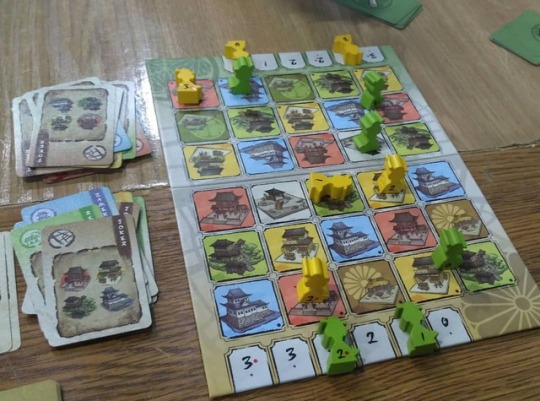
Stratego with a little twist, I like it. #ShadowsInKyoto #TajneAgentki #LucrumGames #EmperorS4 @lucrum_games @emperors4games #boardgame #boardgames #game #games #playgames #analoggame #analoggames #tabletop #tabletopgames #gryplanszowe #gry #grybezpradu #planszowki #stratego #strategygame #gameday (at Kraków, Poland) https://www.instagram.com/p/Bu8SDFFjldb/?utm_source=ig_tumblr_share&igshid=1i7066fsm54aj
#shadowsinkyoto#tajneagentki#lucrumgames#emperors4#boardgame#boardgames#game#games#playgames#analoggame#analoggames#tabletop#tabletopgames#gryplanszowe#gry#grybezpradu#planszowki#stratego#strategygame#gameday
0 notes
Text
Oriflamme, Discovery: The Era of Voyage, Red7- recenzije
Ako nas pratite redovno, znate da društvene igre u malim kutijama uvek nalaze mesto na našem stolu i rancu kada se negde putuje. Posle reda blesavih igara i kuvanja supe, između ostalog, došao je red na još jednu trilogiju mini recenzija, ali ovoga puta okrećemo se suvoj strategiji. […]
The post Oriflamme, Discovery: The Era of Voyage, Red7- recenzije appeared first on PITCHWISE.
from Pitchwise.net: Oriflamme, Discovery: The Era of Voyage, Red7- recenzije
0 notes
Photo
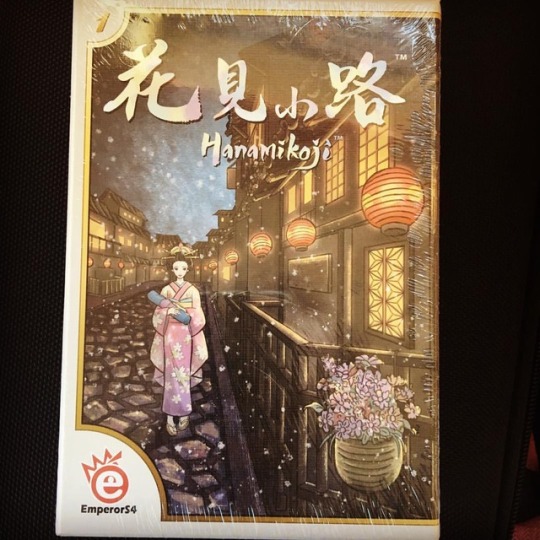
Just received in the post! Good use of a Christmas voucher I hope! Can’t wait to try it! Designed by @kotanakayama with art by @maisherly this game looks truly amazing! #hanamikoji #cardgame #emperors4 #kotanakayama #maisherly #smallboxgames #twoplayer #boardgamegeek #boardgameart #gamegeek #gamenight #bgg
#boardgamegeek#smallboxgames#bgg#cardgame#maisherly#twoplayer#gamenight#boardgameart#hanamikoji#emperors4#kotanakayama#gamegeek
0 notes
Text
Round House na Spieleschmiede
Round House na Spieleschmiede
O jogo RoundHouse tem recebido boas críticas de ilustres reviews pelo mundo fora e agora está em campanha de financiamento na alemã Spieleschmiede – AQUI.
Roundhouse é um jogo de Eros Lin para 2 a 5 jogadores com mais de 10 anos e com uma duração aproximada de 60 minutos.
Image Henk Rollemen
Os jogadores são os líderes de famílias que vão encetar esforços para liderarem as suas famílias ao…
View On WordPress
0 notes
Text
Hanamikoji
Designer: Kota Nakayama Publisher: EmperorS4 Theme: Gifts to Geisha
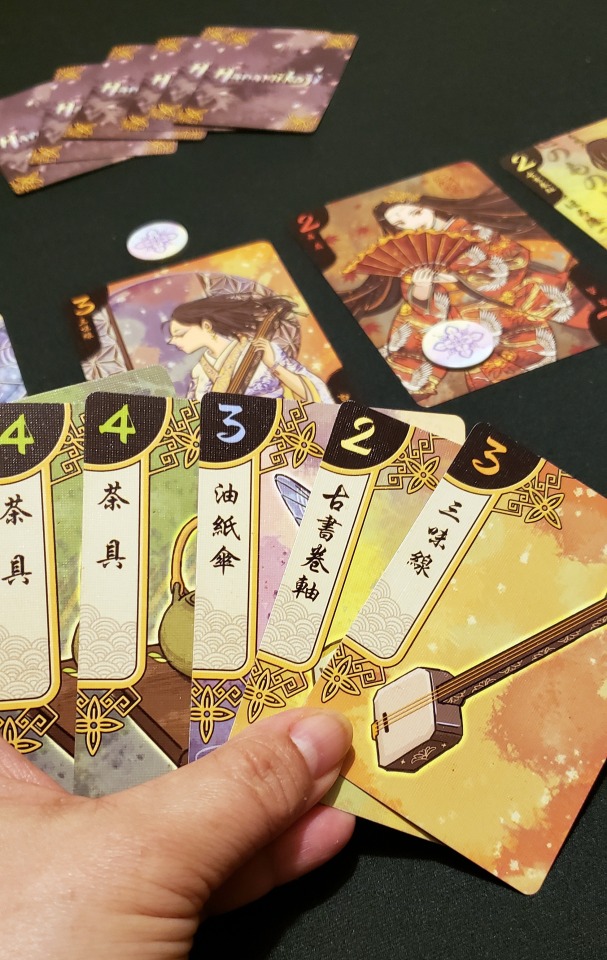
Lili is frustrated by this game because she hasn’t figured out a strategy to win this game. When we say that Hanamikoji is a great abstract two-player game, we mean that it is a beautiful, and very clever brain burner of a card game.
Hanamikoji's cards show geisha art but the theme really has nothing to do with geisha.
Starting with a row of five geisha cards on the table between the both of you, and a hand of object cards each, the winner is the first player who can win over at least 4 geisha - that is, play more (numbered) object cards on their side of a geisha card, than their opponent; or if they are the first to score 11 points.
Each player has only four one-time actions that they can do with the object cards in their hand, and the brain-burning strategy is that two of these actions let your opponent take cards from you. Essentially, the cards you end up playing are what you can predict that your opponent won’t take! Which cards do you offer and gamble with? And in what order? Aaarrgghh!
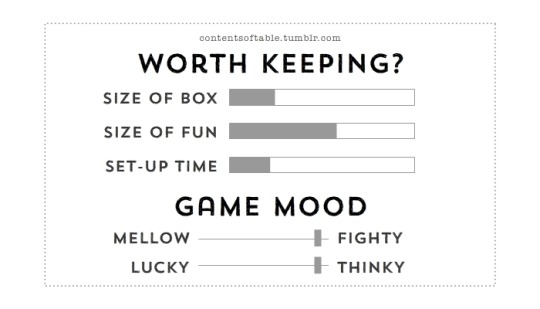
0 notes
Photo

Walking in Burano Review
Walking in Burano is a beautiful little set collection game that combines 3 of our favorite things - beautiful townscapes, set collection featuring multiple scoring strategies, and cats! Check out Game in a Minute for more info!
https://is.gd/hFIWdT
0 notes
Photo
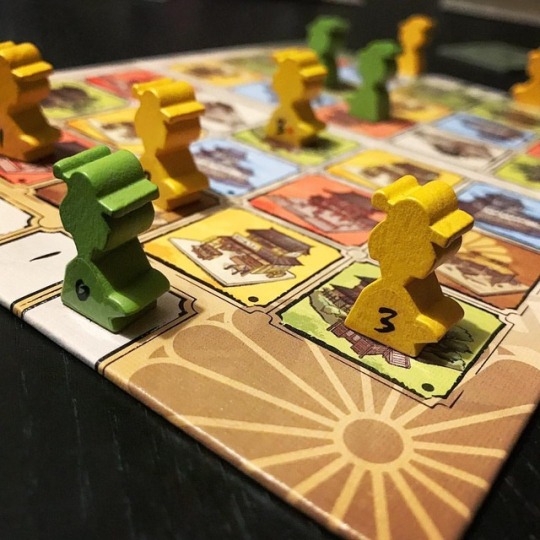
Shadows in Kyoto from @deepwatergames was everything I knew it would be! A nice low luck game with a lot of strategy that plays quickly. Plus, beautiful art! I’ve only scratched the surface with the variability of advanced rules. Can’t wait to play more! @emperors4games . . . . . #shadowsinkyoto #deepwatergames #boardgames #analoggames #bgg #boardgamegeek #juegosdemesa #tabletopgames #jeudesociete #brettspiel #boardgamelove #emperorS4 #juego #boardgame #geishaspies #gamenight #gaymer #gaygeek #geekygaymerguy #ボードゲーム #j2s #geisha
#boardgames#boardgame#geishaspies#shadowsinkyoto#boardgamelove#geisha#tabletopgames#emperors4#j2s#jeudesociete#boardgamegeek#gaymer#bgg#analoggames#brettspiel#deepwatergames#geekygaymerguy#juego#ボードゲーム#juegosdemesa#gaygeek#gamenight
0 notes
Photo
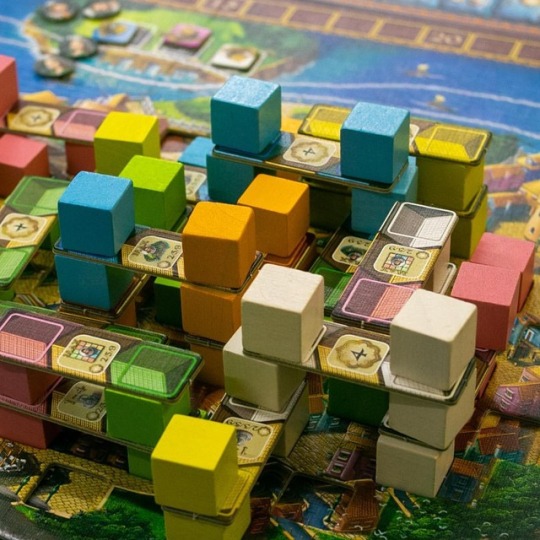
Venha participar do florescimento de BURANO e suas conhecidas construções, neste jogo de Yu-Chen Tseng e Eros Lin pela @emperors4games #yuchentseng #eroslin #emperors4 #burano #venedig #laceisland #veneza #citybuilding #jogosdetabuleiro #tabletopphotography #boardgames #bgg #tabletop #brettspiel https://www.instagram.com/p/BubDA2MBL1h/?utm_source=ig_tumblr_share&igshid=1i3pymtjzw7ua
#yuchentseng#eroslin#emperors4#burano#venedig#laceisland#veneza#citybuilding#jogosdetabuleiro#tabletopphotography#boardgames#bgg#tabletop#brettspiel
0 notes
Text
Benjamin Lavie

Aujourd’hui j’ai l’immense plaisir d’interviewer Benjamin Lavie, le jeune auteur du jeu Singin’ In the Game chez Fée Mumuz’. Il est également le fondateur de sa maison d’édition qui ne compte pour l’instant que ce jeu à son catalogue.

Bonjour Benjamin, tout d’abord un grand merci d’avoir accepté de répondre à mes questions! Peux tu nous décrire ton parcours? J ’ai toujours été joueur, que ce soit de jeux de cartes traditionnels, jeux vidéos, jeux de société etc, mais j’aime aussi certains arts, comme l’écriture et la photo. Lorsqu’une idée vient, j’ai souvent envie de la matérialiser. Or, à 20 ans je suis pleinement tombé dans la marmite des jeux de société modernes et c’est à cette époque qu’est née l’idée de Singin’ in the Game. Il me semblait donc tout naturel de chercher à aller au bout du projet, même si je ne pensais pas encore à l’édition. D’autant que je commençais tout juste mes études pour devenir professeur des écoles, ce que je suis toujours à 75% depuis que j’ai créé Fée Mumuz’. Quel est ton processus de création? J’ai grosso modo créé 3 ou 4 jeux (qui, à l’exception de Singin’ in the Game sont pour l’instant à l’état de prototypes). Le premier (Singin’ in the Game!) est né d’une frustration ( “Bon sang! Ce serait trop bien un jeu de ce genre, ça doit forcément exister! Quoi, ce n’est pas le cas?! Horreur, malheur, bon et bien dans ce cas je m’y colle). Le second a plus été un challenge lancé par un pote et le troisième, une subite envie de créer le jeu d’une émission TV que je n’arrêtais pas de visionner. D’une façon générale, j’ai à cœur d’essayer d’apporter une expérience de jeu nouvelle, de créer des jeux qui ne ressemblent pas à d’autres, je dirais donc que chez moi, c’est souvent le manque qui me donne l’envie de créer. Cela dit, j’ai également participé à la protojam du FLIP 2019 et j'y ai retrouvé les sensations des ateliers d’écriture auxquels j’ai pu prendre part. C’est très chouette également de partir d’une contrainte et d’avoir un temps donné pour parvenir à un résultat. Comment t’est venu l’idée de ton jeu, Singin’ in the Game? L’idée m’est venue en jouant à un autre jeu musical: “Hitstory”. En gros on nous demandait, qui a chanté un titre. Si on trouvait, on marquait des points, si on le fredonnait, on en marquait également. J’étais frustré de voir qu’on ne pouvait pas chanter tous les titres de nos artistes favoris et que, comme dans beaucoup de jeux ou d’émissions musicales, on s’en tiennent souvent aux artistes et aux titres les plus “grand public”. Je voulais une jeu dans lequel tout le monde se retrouverait, qu’importe les go��ts, qu’importe l’âge. Une espèce d’encyclopédie (pour son côté complet), mais un véritable jeu d’ambiance malgré tout.)

Pourquoi avoir décidé de créer ta propre maison d’édition plutôt que de proposer ton jeu aux éditeurs existants? J’ai tout d’abord proposé le jeu aux éditeurs mais pour la plupart, cela ne correspondait pas à leur ligne éditoriale. Il faut dire que les jeux de culture ne sont pas forcément ce que recherchent les joueurs habitués aux jeux de société modernes. Alors si on ajoute le fait qu’il s’agisse d’un jeu “musical”, à ce côté culturel, cela peut sembler très clivant. De mon côté, j’avais toujours cherché à éviter d’éditer moi-même Singin’ in the Game, car la paperasse, les recherches de fabricants etc, ça ne m’emballait guère. Mais j’ai également vu le retour des gens en festivals, le plaisir qu’ils prenaient à (re)découvrir des titres et des artistes, l’ambiance que cela amenait à la table. Ça m’a boosté et je me suis dit que culturellement et socialement, ce jeu devait exister, que j’avais travaillé de nombreuses années dessus et qu’il fallait que j’aille au bout pour que tous ceux qui désireraient l’avoir puissent y jouer avec leurs proches. Peu de temps avant que je ne me lance dans l’édition de Singin’ in the Game et de ses extensions, quelques éditeurs se sont tout de même montrés intéressés par son édition. Mais à ce moment là, je m’étais déjà trop projeté sur le financement participatif et je n’étais plus prêt à lâcher le bébé. En effet, si je savais que devenir éditeur ne serait pas une mince affaire, je trouvais professionnellement très enrichissant de réaliser seul toutes les étapes du projet afin d’en saisir tous les rouages. C’est grâce à cela que j’ai pu endosser toutes ces casquettes: auteur, animateur, commercial, publicitaire, éditeur... Quelle est la ligne éditoriale de Fée Mumuz’? Ma ligne éditoriale est d’éditer des jeux funs et faciles à prendre en main afin de permettre au plus grand nombre de jouer à tout moment. Je m’oriente donc vers des jeux familiaux ou familiaux +, si possible jouable de 2 à 5-6 joueurs et plus, qui durent moins d’une heure et dont l’épaisseur du livret de règles ne serait pas décourageante. Où sont distribués tes jeux? Pour le moment c’est Ludistri qui s’occupe de la distribution de mes jeux. Je sais qu’ils sont trouvables dans plus d’une quarantaine de boutiques un peu partout en France et en Suisse mais je n’ai pas la liste exacte de ceux qui l’ont. Toutefois, Singin’ in the Game et ses extensions sont toujours disponibles sur le site Fée Mumuz’ si on ne le trouve pas ailleurs. Tu semble privilégier les distributions en boutique physique, pourquoi? Pas nécessairement mais comme je suis un jeune éditeur, je n’ai pas pu me permettre de faire imprimer une énorme quantité de jeux , ce qui aurait réduit les coûts. De plus, j’avais à cœur de ne pas faire fabriquer le jeu en Chine donc le coût final du jeu s’en ressent, ce qui je pense, peut freiner certains sites internet. En tant que joueur, quel est ton jeu préféré? Impossible de donner un top 1! Kingdomino, Le Petit prince “fabrique-moi une planète”, The Island, Balade à Burano, Iquazu, Bienvenue à bord, Unanimo, Coloretto, Metropolys, Patchwork, The Boss, Medieval academy… ce sont des jeux que j’adore, mais il y en a tellement (j’en ai environ 400 chez moi). D’une manière générale, j’aime beaucoup les jeux qui sont à la fois simples tout en ayant une dimension stratégique.


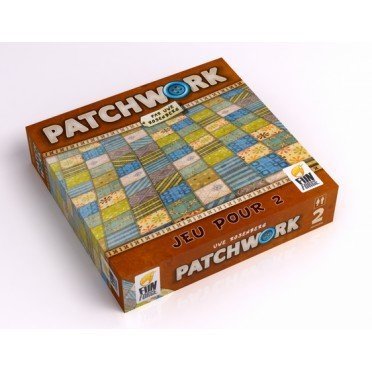

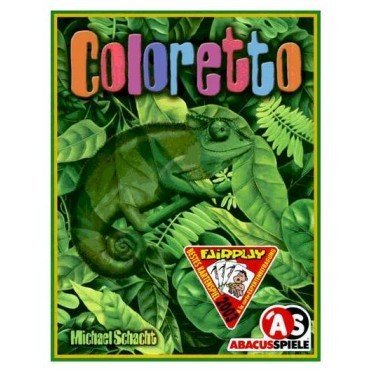
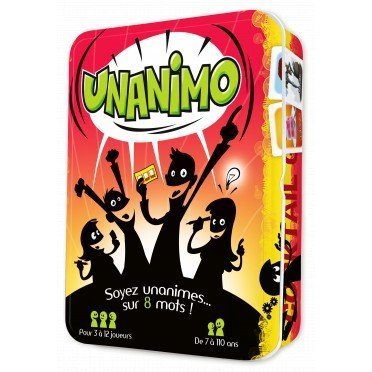


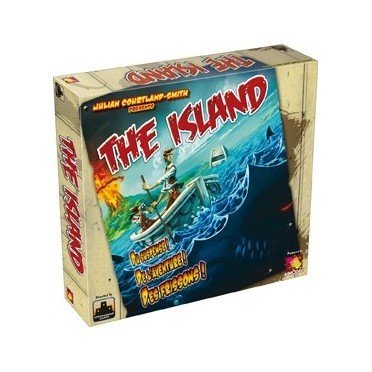
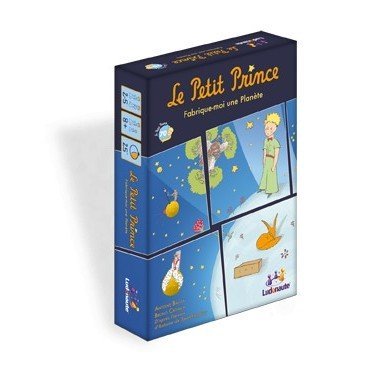


Selon toi, quel serait un jeu sous-coté? Je n’ai pas de définition précise mais j’imagine qu’on a plus de chance de trouver des jeux sous-côtés chez les petits éditeurs qui n’ont pas la même crédibilité que les éditeurs installés depuis plus longtemps. Ils n’ont en général pas les mêmes capacités non plus. La communication (vidéos, publicités), développer son site internet, proposer des concours, être présents sur tous les festivals, ça prend du temps (ou/et des hommes) et ça a un coût. Il faut faire donc faire des choix, ce qui inclut que certaines pépites ludiques puissent passer inaperçu. De plus, je pense que la plupart des médias s’intéressent avant tout aux jeux, aux auteurs et aux éditeurs reconnus ou qui buzzent (ce qui se comprend, cela fait forcément des articles et des vidéos plus lus/vues) ce qui peut laisser de très bons jeux dans l’ombre. On a très peu entendu parler de “Balade à Burano” par exemple qui est à mon sens aussi beau que bon. Sans doute parce qu’il a été édité par “EmperorS4” qui n’est pas très connu ou mis en valeur en France. A Cannes j’ai également eu le plaisir de tester “Cuisto Fury” de Ludiconcept que j’ai trouvé vraiment sympa, “Iquazù” chez Haba n’a pas buzzé et pourtant il est super aussi, tout comme “Bienvenue à bord” qui est génial mais n’est pas sorti en boutique (il était réservé à l’origine aux participants des croisières “Captain Meeple”). Je dirais donc qu’un jeu sous-côté est un bon ou très bon jeu dont on a hélas trop peu parlé.


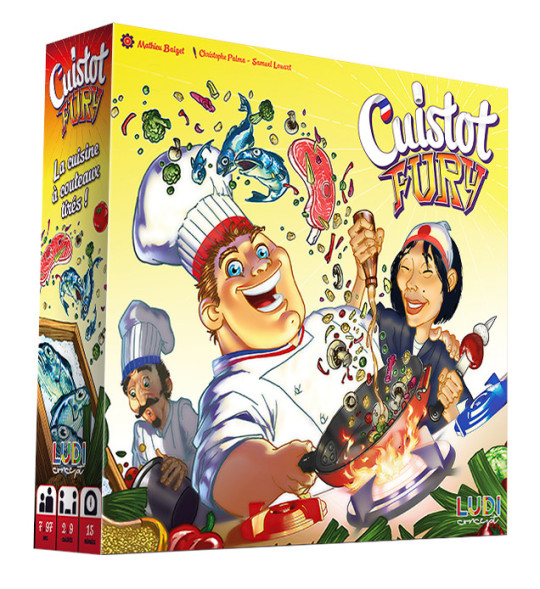

As tu un scoop à nous partager? Je travaille depuis de longues années sur la genèse de Singin’ in the Game et de Fée Mumuz’. De la naissance de l’idée, aux festivals en passant par le financement participatif et les partenariats divers, l’idée est de retrouver tous les éléments qui peuvent se cacher derrière la création et l’édition d’un jeu. Or, j’ai profité du confinement pour réécrire ce document (qui faisait plus de 900 pages A4 à la base)! Plus qu’à le relire et faire les dernières corrections et ceux qui voudraient avoir un aperçu de l’envers du décor le pourront! Pour continuer cette interview, je te propose de sortir le jeu “Questions de merde” Je tire 3 cartes, prêt? Voici les questions de la première carte: Que dois tu toujours faire avant de sortir en soirée? La première chose à faire est de préparer le sac de jeux (que je blinde)! Ensuite je prends à boire ou à manger histoire de ne pas venir les mains vides. Que faut-il obligatoirement apprendre à un enfant? Ahah et c’est à un maître d’école que vous demandez ça? Je dirais l’empathie et la politesse. Le monde manque cruellement de gens qui cherchent à comprendre les autres. Quelle est ton astuce pour mettre de l’argent de côté? Je me contente de peu. J’achète de plus en plus de produits d’occasion également (écologiquement c’est sans doute bien mieux). Ah, et puis d’une façon générale, je me fiche de porter ou de manger de la marque. Ça aide! Voici les questions de la deuxième carte: Quel jeu télévisé pourrais tu gagner facilement? Euhhhh…burger quizz peut-être (mais ne comptez pas sur moi pour le burger de la mort)! Et je ne serai pas fichu de gagner à “N'oubliez pas les paroles” malgré ce que l’on suppose souvent. Je connais quelques paroles de beaucoup de chansons, mais quasiment aucune par cœur). De quoi avais tu peur quand tu étais petit? Des serpents, à la Indiana Jones! Selon toi, quelle est la loi la plus stupide du pays? J’aurais tendance à dire que toutes les lois qui cherchent à faire payer les plus pauvres en omettant de parler d’évasion fiscale sont des lois débiles...M’enfin, il y en a bien d’autres, mais évitons de trop parler politique! Voici les questions de la dernière carte: Quel produit fait maison pourrais tu vendre au bord de la route? Ce serait sans doute des poèmes qui me serviraient à “payer” les personnes qui m'emmènerait à bon port. Cela ne demanderait pas trop de matériel et l’inspiration viendrait des rencontres. L’idée me plait bien! Si tu pouvais être mécène, que financerais tu? Les associations écologiques et celles qui donnent aux personnes dans le besoin (Restos du Cœur). A quelle époque aurais-tu aimé vivre? Ahah, on m’a souvent dit que je n’étais pas né à la bonne époque. Je crois que j’aurais aimé naître au milieu des années 50 histoire de découvrir les Beatles à l’adolescence avant d’enchaîner avec les 70’s et les 80’s. Le top. Sinon, il n’y a pas vraiment d’époque historique ou lointaine qui me fait rêver. Question Bonus: qui aimerais-tu que j'interviewe après et quelle question souhaiterais tu lui poser? J’aimerais que tu interviewes Guillaume Luton de Worldwide games et que tu lui demandes “A quand un jeu sur un sport atypique”? (type fléchettes, pétanque, baseball, pêche, biathlon etc). Si tu l’as déjà interviewé, j’aimerais alors que tu te tournes vers David Pérez de Flyin’ games et que tu lui demandes “Quand est-ce qu’on s’organise un petit poker?”. Merci beaucoup, Benjamin d’avoir répondu à mes questions! Nous allons suivre l’évolution de ta petite maison d’édition avec intérêt! Merci à toi! C’est vraiment chouette et sympa de ta part de mettre un coup de projecteur sur les petites maisons d’édition!

Read the full article
0 notes
Photo

Just finished and printed my coins to #Hanamikoji One painted and varnished, six to go :D #3dprinting #3dprint #anycubic #anycubicphoton #coins @anycubicofficial #Gejsze #NaszaKsiegarnia @naszaksiegarnia #kosmos #emperors4 #boardgame #boardgames #game #games #playgames #analoggame #analoggames #tabletop #tabletopgames #gryplanszowe #gry #grybezpradu #planszowki #gamenight #grakarciana #cards #cardgame (at Kielce, Poland) https://www.instagram.com/p/BpUz2JSDjII/?utm_source=ig_tumblr_share&igshid=12fp6o4ghs8c9
#hanamikoji#3dprinting#3dprint#anycubic#anycubicphoton#coins#gejsze#naszaksiegarnia#kosmos#emperors4#boardgame#boardgames#game#games#playgames#analoggame#analoggames#tabletop#tabletopgames#gryplanszowe#gry#grybezpradu#planszowki#gamenight#grakarciana#cards#cardgame
0 notes
Photo

Deepwater Games To Bring Titles From EmperorS4 To North America In 2018 Read the full article at DiceTowerNews.com http://www.dicetowernews.com/deepwater-games-to-bring-titles-from-emperors4-to-north-america-in-2018/48159
#BoardGameNews #BoardGames #DiceTowerNews
1 note
·
View note